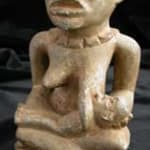Yombe Maternity Sculpture (Ntadi), 16th Century CE - 18th Century CE
Stone
8
PF.6234a
Further images
Graves are of special importance to the tribes of the Congo and other central African peoples, not just as resting places for the dead but also as points of contact...
Graves are of special importance to the tribes of the Congo and other central African peoples, not just as resting places for the dead but also as points of contact with the deceased. Although generally associated with the Mboma tribe, peoples on either side of the Congo River estuary carve figures in stone, using techniques modeled from ancient wood-sculpting traditions. These figures were called ntadi, a word that probably comes from tadi, "stone," but may also refer to tala, "to look at," implying that the figures are witnesses in this world for the deceased in the other. Found on graves in abandoned cemeteries, the ntadi statues are often discovered deeply imbedded in the earth. Questions about the age and tribal function of these remarkable sculptures remain plaguing. This striking ntadi represents a mother and her suckling child. Resting in her lap, the infant feeds upon her swollen breasts, reflecting the fecundity and fertility of the woman. The mother wears a beaded necklace and a tight-fitting skull cap, both of which reflect her wealth and high-ranking position within her society. This mysterious sculpture is even more spectacular when one considers where it was placed. Might this statue have marked the grave of a deceased mother whose offspring memorialized her being? Perhaps this figure is a medium through which her descendants can continue to communicate with her. The theme of this work suggests that, although departed, this mother will continue nurturing her children from beyond.





